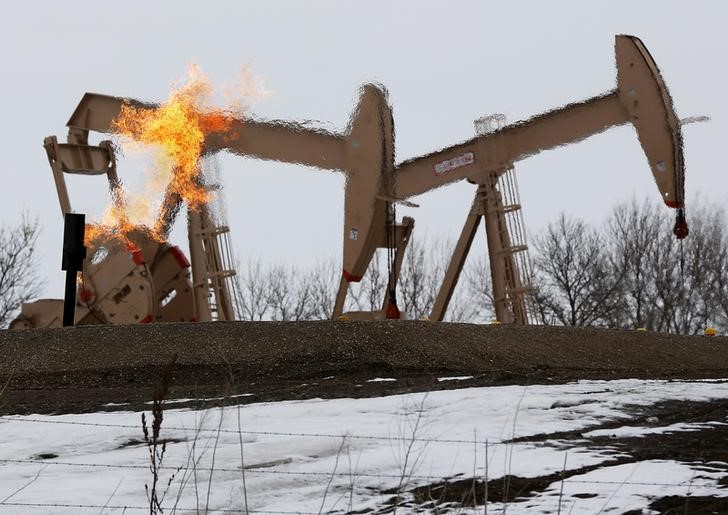(For a live blog on the U.S. stock market, click LIVE/ or
type LIVE/ in a news window)
* Emergency cutouts halt trading after opening
* Losses across the board deepen coronavirus sell-off
* Energy stocks plummet as oil slumps
* Indexes down: Dow 6.51%, S&P 6.15%, Nasdaq 5.42%
(Updates to early afternoon)
By Medha Singh and Sanjana Shivdas
March 9 (Reuters) - Wall Street's main stock indexes
plummeted about 5% on Monday, as a slump in oil prices and the
rapid spread of the coronavirus amplified fears of a global
recession on the anniversary of the U.S. stock market's longest
bull run.
The S&P 500 .SPX was set for its biggest one-day
percentage fall since Aug. 8, 2011, when ratings agency S&P
downgraded U.S. sovereign debt. The Dow Jones Industrials .DJI
briefly lost more than 2,000 points as investors fled to
safe-haven assets like bonds and the Japanese yen.
The energy .SPNY index plunged 18.2% to its lowest level
since August 2004 and crude prices were on track for their worst
day in three decades as Saudi Arabia and Russia moved to
significantly ramp up production after the collapse of a supply
cut agreement. O/R
Companies listed on the S&P 500 have now lost more than $5
trillion in value in a sell-off sparked by fears that the
coronavirus epidemic could tip the global economy into
recession.
"There is potential that we could be at the start of a
financial crisis part two," said Dennis Dick, head of markets
structure, proprietary trader at Bright Trading LLC in Las
Vegas.
"It's a possibility right now that wasn't on the table until
we had this oil plunge over the weekend."
Trading was halted immediately after the opening as the S&P
500 .SPX tumbled 7%, triggering an automatic 15-minute cutout
originally put in place to avoid a repeat of the "Black Monday"
crash in 1987, when the Dow slumped nearly 23%.
The circuit breakers were adjusted in 2012 - the thresholds
needed to trigger a trading pause were lowered and the S&P 500
replaced the Dow as the benchmark index.
The S&P 500 has fallen 18% from its record high hit as
recently as three weeks ago, and stands only about 3% away from
moving into bear market territory, in one of the most dramatic
swings ever.
Wall Street's fear gauge .VIX , halted for the first half
hour after opening, jumped to its highest level since the 2008
crisis.
Oil majors Chevron Corp CVX.N and Exxon Mobil Corp
XOM.N , fell more than 7%, each to hit multi-year lows.
At 1:12 p.m. ET, the Dow Jones Industrial Average .DJI was
down 1,628.16 points, or 6.29%, at 24,236.62 and the S&P 500
.SPX was down 175.94 points, or 5.92%, at 2,796.43. The Nasdaq
Composite .IXIC was down 443.18 points, or 5.17%, at 8,132.44.
Underlining the broad-based tumble, declining issues
outnumbered advancers for an 18-to-1 ratio on the NYSE and a
17-to-1 ratio on the Nasdaq.
The yield on the benchmark 10-year U.S. Treasury US10YT=RR
hit a record low again, sending the rate-sensitive financials
index .SPSY down 9.8%. US/
Traders now expect U.S. Federal Reserve policymakers to cut
interest rates for the second time this month when they meet
next week.
The S&P index recorded one new 52-week high and 215 new
lows, while the Nasdaq recorded nine new highs and 924 new lows.
<^^^^^^^^^^^^^^^^^^^^^^^^^^^^^^^^^^^^^^^^^^^^^^^^^^^^^^^^^^^
S&P energy relative to S&P 500 vs crude https://tmsnrt.rs/38RxTL9
US crude price vs energy sector ETF https://tmsnrt.rs/2TPLlcD
Plunging oil, coronavirus stoke credit concerns https://tmsnrt.rs/2TBKldj
^^^^^^^^^^^^^^^^^^^^^^^^^^^^^^^^^^^^^^^^^^^^^^^^^^^^^^^^^^^>
(Writing by Sagarika Jaisinghani; Editing by Saumyadeb
Chakrabarty and Sriraj Kalluvila)
